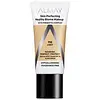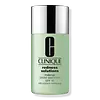Almay Skin Perfecting Healthy Biome Makeup Versus Clinique Redness Solutions Makeup Broad Spectrum SPF 15 Foundation
What's inside
What's inside
 Key Ingredients
Key Ingredients

 Benefits
Benefits

 Concerns
Concerns

 Ingredients Side-by-side
Ingredients Side-by-side

Water
Skin ConditioningCyclopentasiloxane
EmollientButyloctyl Salicylate
Skin ConditioningCetyl PEG/PPG-10/1 Dimethicone
EmulsifyingTrimethylsiloxysilicate
EmollientGlycerin
HumectantIsododecane
EmollientAlumina
AbrasiveMagnesium Sulfate
Silica
AbrasiveAlpha-Glucan Oligosaccharide
CleansingCaprylic/Capric Triglyceride
MaskingCaprylyl Glycol
EmollientCetyl Palmitate
EmollientDisteardimonium Hectorite
StabilisingHydrogen Dimethicone
Hydrogenated Lecithin
EmulsifyingLactobacillus
Skin ConditioningMaltodextrin
AbsorbentOphiopogon Japonicus Root Extract
Skin ConditioningPalmitoyl Tetrapeptide-10
Skin ConditioningPolyglyceryl-3 Diisostearate
EmulsifyingPolymnia Sonchifolia Root Juice
Skin ConditioningPolysorbate 80
EmulsifyingPropylene Carbonate
SolventSimethicone
EmollientSorbitan Stearate
EmulsifyingTetrasodium EDTA
Tocopheryl Acetate
AntioxidantTriethoxycaprylylsilane
Phenoxyethanol
PreservativeIron Oxides
CI 77492
Cosmetic ColorantCI 77499
Cosmetic ColorantCI 77891
Cosmetic ColorantWater, Cyclopentasiloxane, Butyloctyl Salicylate, Cetyl PEG/PPG-10/1 Dimethicone, Trimethylsiloxysilicate, Glycerin, Isododecane, Alumina, Magnesium Sulfate, Silica, Alpha-Glucan Oligosaccharide, Caprylic/Capric Triglyceride, Caprylyl Glycol, Cetyl Palmitate, Disteardimonium Hectorite, Hydrogen Dimethicone, Hydrogenated Lecithin, Lactobacillus, Maltodextrin, Ophiopogon Japonicus Root Extract, Palmitoyl Tetrapeptide-10, Polyglyceryl-3 Diisostearate, Polymnia Sonchifolia Root Juice, Polysorbate 80, Propylene Carbonate, Simethicone, Sorbitan Stearate, Tetrasodium EDTA, Tocopheryl Acetate, Triethoxycaprylylsilane, Phenoxyethanol, Iron Oxides, CI 77492, CI 77499, CI 77891
Ethylhexyl Methoxycinnamate 5.9%
UV AbsorberTitanium Dioxide 3.7%
Cosmetic ColorantZinc Oxide 2.9%
Cosmetic ColorantWater
Skin ConditioningMethyl Trimethicone
Skin ConditioningPhenyl Trimethicone
Skin ConditioningTriethylhexanoin
MaskingButylene Glycol
HumectantDimethicone
EmollientTrimethylsiloxysilicate
EmollientPEG-10 Dimethicone
Skin ConditioningLauryl PEG-9 Polydimethylsiloxyethyl Dimethicone
Skin ConditioningC12-15 Alkyl Benzoate
AntimicrobialLactobacillus Ferment
Skin ConditioningCitrus Grandis Peel Extract
AstringentMagnolia Grandiflora Bark Extract
AntimicrobialPoria Cocos Sclerotium Extract
AstringentAstrocaryum Murumuru Seed Butter
EmollientGlycerin
HumectantCaffeine
Skin ConditioningCaprylyl Methicone
Skin ConditioningStearic Acid
CleansingMethicone
EmollientPolyglyceryl-6 Polyricinoleate
EmulsifyingAcetyl Glucosamine
Skin ConditioningDisteardimonium Hectorite
StabilisingIsopropyl Titanium Triisostearate
EmollientDimethicone Crosspolymer-3
Skin ConditioningLecithin
EmollientTocopheryl Acetate
AntioxidantLaureth-7
EmulsifyingDimethicone/PEG-10/15 Crosspolymer
Sodium Chloride
MaskingDipropylene Glycol
HumectantDisodium EDTA
Aluminum Hydroxide
EmollientPhenoxyethanol
PreservativeMica
Cosmetic ColorantCI 77891
Cosmetic ColorantCI 77492
Cosmetic ColorantCI 77491
Cosmetic ColorantCI 77499
Cosmetic ColorantEthylhexyl Methoxycinnamate 5.9%, Titanium Dioxide 3.7%, Zinc Oxide 2.9%, Water, Methyl Trimethicone, Phenyl Trimethicone, Triethylhexanoin, Butylene Glycol, Dimethicone, Trimethylsiloxysilicate, PEG-10 Dimethicone, Lauryl PEG-9 Polydimethylsiloxyethyl Dimethicone, C12-15 Alkyl Benzoate, Lactobacillus Ferment, Citrus Grandis Peel Extract, Magnolia Grandiflora Bark Extract, Poria Cocos Sclerotium Extract, Astrocaryum Murumuru Seed Butter, Glycerin, Caffeine, Caprylyl Methicone, Stearic Acid, Methicone, Polyglyceryl-6 Polyricinoleate, Acetyl Glucosamine, Disteardimonium Hectorite, Isopropyl Titanium Triisostearate, Dimethicone Crosspolymer-3, Lecithin, Tocopheryl Acetate, Laureth-7, Dimethicone/PEG-10/15 Crosspolymer, Sodium Chloride, Dipropylene Glycol, Disodium EDTA, Aluminum Hydroxide, Phenoxyethanol, Mica, CI 77891, CI 77492, CI 77491, CI 77499
Ingredients Explained
These ingredients are found in both products.
Ingredients higher up in an ingredient list are typically present in a larger amount.
Ci 77492 is also hydrated iron III oxide. It's sole purpose is to give a yellow hue to products.
Iron III oxides are classified as inorganic chemicals for coloring.
Synthetically created Ci 77492 is considered safer than those naturally found. This is because the synthetically created version may contain less impurities. Iron oxides are generally non-toxic and non-allergenic.
Learn more about CI 77492Ci 77499 is also hydrated iron III oxide. It is created from mixing red and black iron oxides. This helps give shades of darkness to a product.
Iron III oxides are classified as inorganic chemicals for coloring.
Ci 77891 is a white pigment from Titanium dioxide. It is naturally found in minerals such as rutile and ilmenite.
It's main function is to add a white color to cosmetics. It can also be mixed with other colors to create different shades.
Ci 77891 is commonly found in sunscreens due to its ability to block UV rays.
Learn more about CI 77891Disteardimonium Hectorite comes from the clay mineral named hectorite. It is used to add thickness to a product.
It can also help stabilize a product by helping to disperse other ingredients.
Hectorite is a rare, white clay mineral.
Learn more about Disteardimonium HectoriteGlycerin is already naturally found in your skin. It helps moisturize and protect your skin.
A study from 2016 found glycerin to be more effective as a humectant than AHAs and hyaluronic acid.
As a humectant, it helps the skin stay hydrated by pulling moisture to your skin. The low molecular weight of glycerin allows it to pull moisture into the deeper layers of your skin.
Hydrated skin improves your skin barrier; Your skin barrier helps protect against irritants and bacteria.
Glycerin has also been found to have antimicrobial and antiviral properties. Due to these properties, glycerin is often used in wound and burn treatments.
In cosmetics, glycerin is usually derived from plants such as soybean or palm. However, it can also be sourced from animals, such as tallow or animal fat.
This ingredient is organic, colorless, odorless, and non-toxic.
Glycerin is the name for this ingredient in American English. British English uses Glycerol/Glycerine.
Learn more about GlycerinPhenoxyethanol is a preservative that has germicide, antimicrobial, and aromatic properties. Studies show that phenoxyethanol can prevent microbial growth. By itself, it has a scent that is similar to that of a rose.
It's often used in formulations along with Caprylyl Glycol to preserve the shelf life of products.
Tocopheryl Acetate is AKA Vitamin E. It is an antioxidant and protects your skin from free radicals. Free radicals damage the skin by breaking down collagen.
One study found using Tocopheryl Acetate with Vitamin C decreased the number of sunburned cells.
Tocopheryl Acetate is commonly found in both skincare and dietary supplements.
Learn more about Tocopheryl AcetateThis silicone is an emollient. Emollients create a thin film on the skin to prevent moisture from escaping.
It is not soluble in water and helps increase water-resistance in products.
According to a manufacturer, it can blend seamlessly with silicone oils, such as Cyclopentasiloxane.
Learn more about TrimethylsiloxysilicateWater. It's the most common cosmetic ingredient of all. You'll usually see it at the top of ingredient lists, meaning that it makes up the largest part of the product.
So why is it so popular? Water most often acts as a solvent - this means that it helps dissolve other ingredients into the formulation.
You'll also recognize water as that liquid we all need to stay alive. If you see this, drink a glass of water. Stay hydrated!
Learn more about Water